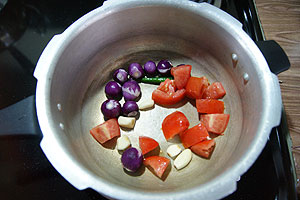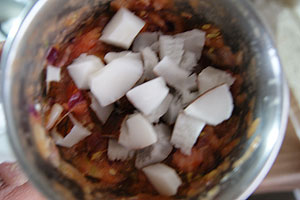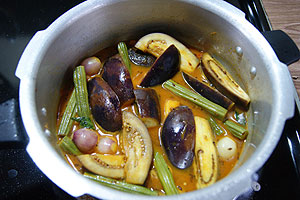My 84th recipe, "Mochakottai Kuzhambu (Gravy)", a very healthy South Indian Kuzhambu. Perfect to have along with steamed white rice or as a side for idli/dosa.
Wondering what Mochakottai is? Mochakottai, also known just as Mochai, is a high protein rich dry bean extensively used in South Indian cuisine. And, when I wanted to post this recipe with mochai, I went on a google mission to find out the English name for Mochakottai.
But the mission was a failure. Looks like Mochakottai is a dry bean which is very native to the Indian region. However there are other beans which are close relatives of this bean like the broad beans, baby lima beans, fava beans, etc. Hence you can replace mochakottai with any other dry bean which you can get your hands on. However I would strongly recommend using the mochakottai since there is no match for their taste.
My mom generally makes mochakottai kuzhambu atleast once in 2 weeks. She says that mochakottai is high in protein and other nutrients and helps in maintaining a healthy and shiny skin. This is a modified version of the kuzhambu my mom used to make.
With the addition of coconut and other ingredients, it tastes even better, and just like how I like it. It would be the perfect pair with a bowl of steamed rice, idli or dosa. And the taste would be even better when you have it for the second day, when the flavors get a chance to mix well.
Mochakottai Kuzhambu

Mochakottai Kuzhambu
Ingredients
- ¾ Dry Mochai - ¾ Cup
- 8 Red Shallots | Red pearl onions | Small onions
- ½ large Tomato (Chopped)
- 3 Brinjal (Chopped lengthwise)
- 1 Drumstick (Chopped into 2 inch sticks)
- ¼ tsp Turmeric
- 1 ½ tsp Sambar powder
- ¼ tsp Asafoetida
- 1 tsp Salt (adjust per taste)
- Tamarind - Medium gooseberry size
- Coriander leaves - For garnishing
To Grind
- ¼ tsp Oil
- 10 Red Shallots | Red pearl onions | Small onions
- ½ large Tomato (Chopped)
- 1 small Green Chilli
- 4 cloves Garlic
- ⅓ Cup Coconut (Chopped)
- ½ tsp Fennel seeds
To Temper
- 2 tsp Oil
- ¼ tsp Mustard
- ½ tsp Broken urad dal
- ½ tsp Jeera
- 1 sprig Curry leaves
- 3 cloves Garlic (sliced)
Instructions
- First wash and soak the mochai overnight. Then pressure cook them along with a pinch of salt and asafoetida by adding about a cup of water for 4 whistles or until soft. Keep aside.
- Soak the tamarind and extract half a cup of tamarind juice by adding required water. Keep aside.
- Heat a pan with ¼ tsp of oil and add all the ingredients given under "To grind", except coconut and fennel seeds. Saute for 2-3 mins until the onions start becoming translucent. Transfer them to the plate, let them cool down to room temperature and then grind them in a mixie along with coconut and fennel seeds to a fine paste. Keep aside.
- Now heat a pan with oil, add the mustard and once the mustard splutters, add the other ingredients listed under "To temper" in the given order. once the broken urad dal starts turning golden brown, add the curry leaves, garlic, small onion and saute until the onion turns translucent.
- Now add the tomato, brinjal, drumstick and saute for 2 minutes. Add a cup of water and give a quick mix. Now add all the powders (turmeric, sambar, asafoetida, and salt) and give a quick stir.
- Add the prepared ground paste along with a cup of water and give a stir. Let the kuzhambu come to a boil. Once it starts to boil turn the flame to low-medium and let the gravy keep cooking until the veggies are ¾ done.
- Now add the tamarind extract and continue cooking until the raw smell of tamarind is gone and veggies are almost done. Now add the cooked mochai (along with the water used while cooking them) into the gravy and cook until the desired consistency is reached. Turn off the flame.
- Enjoy hot with rice/idli/dosa or chappati.
Notes | FAQ

Submitted this recipe to Remmy's Kitchen First blog anniversary celebration and giveaway.























Divya says
I cooked it... Yayyyh... Wish i could post the pic... It turned out to be a awesome curry... My films absolutely loved it
I usually try with chicken and this bean, almost the same ingredients.. Little variations of course... Byt that as well tastes really great..
revifood says
Thanks for trying Divya, glad everyone liked it 🙂
Tamara says
It's called kima beans in English.
Tamara says
Oops sorry my spell check changed Lima beans to kima beans haha
revifood says
Hi Tamara, I am not sure if Lima beans is an exact match for mochakottai. But i think it is pretty close 🙂
pamela says
I found on some sites they may be called Hyacinth bean or perhaps Val bean.
Could this be them::
https://en.m.wikipedia.org/wiki/Lablab
Your dish looks so good and yummy. So many nice veggies and beans!!
revifood says
Thanks Pamela for the nice info. It could well be the bean which is on the wiki link you shared 🙂 Even if it is not, the gravy would still taste good with any bean used.